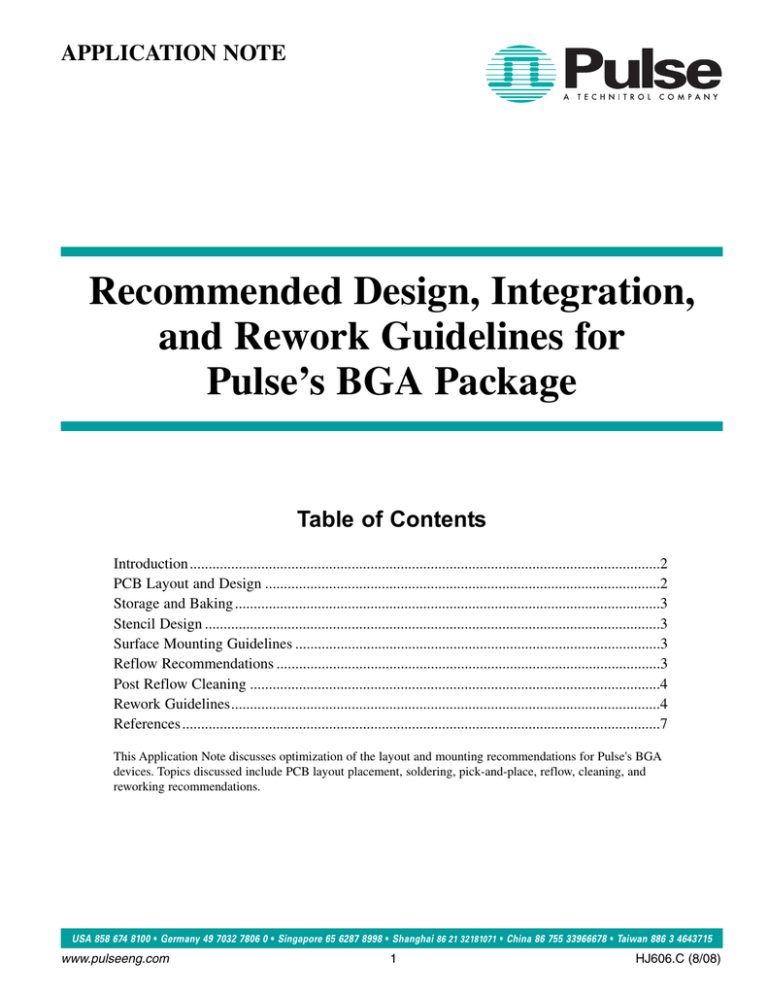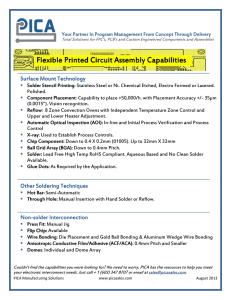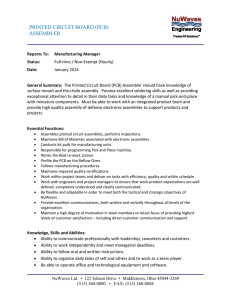
APPLICATION NOTE
Recommended Design, Integration,
and Rework Guidelines for
Pulse’s BGA Package
Table of Contents
Introduction .............................................................................................................................2
PCB Layout and Design .........................................................................................................2
Storage and Baking .................................................................................................................3
Stencil Design .........................................................................................................................3
Surface Mounting Guidelines .................................................................................................3
Reflow Recommendations ......................................................................................................3
Post Reflow Cleaning .............................................................................................................4
Rework Guidelines..................................................................................................................4
References ...............................................................................................................................7
This Application Note discusses optimization of the layout and mounting recommendations for Pulse's BGA
devices. Topics discussed include PCB layout placement, soldering, pick-and-place, reflow, cleaning, and
reworking recommendations.
USA 858 674 8100 • Germany 49 7032 7806 0 • Singapore 65 6287 8998 • Shanghai 86 21 32181071 • China 86 755 33966678 • Taiwan 886 3 4643715
www.pulseeng.com
1
HJ606.C (8/08)
APPLICATION NOTE:
Recommended Design, Integration, and Rework
of Guidelines for Pulse’s BGA Package
Introduction
Pulse's BGA (Bump Grid Array) devices are high
performance microelectronic devices designed to provide
efficient and reliable operation. This application note
discusses optimization of the layout and mounting
recommendations for these devices. Topics include PCB
layout, placement, soldering, pick-and-place, reflow,
cleaning, and rework recommendations, which are
provided to ensure that performance and reliability are
not compromised.
Figure 2. Comparison between solder mask defined pad
and non- solder mask defined pad.
It is recommended that the land pads on the
motherboard should be Non-Solder Mask Defined.
For Pulse BGA devices, the required land pad is
0.762mm in diameter (Figure 3). This diameter
provides the optimum stand-off height and
performance reliability.
1.0 PCB Layout and Design
To achieve maximum reliability and optimum electrical
performance, the design of the PCB onto which the device
is mounted should be considered. Specifically, the PCB
routing, solder mask opening design, and termination
should follow these guidelines.
1.1 PCB Routing and Land Pad Design
The PCB to which the devices are attached should meet
the IPC-A-610 specifications. Figure 1 shows an example
of the recommended pad and via design. As shown in
this figure, Pulse recommends the use of NSMD (NonSolder Mask Defined) pads for BGA lands. However,
the use of SMD (Solder Mask Defined) pads would also
be acceptable. The use of NSMD pads will provide the
best reliability and electrical performance. Figure 2 shows
the differences between SMD pads and NSMD pads.
Pulses BGA Device
PCB
Figure 3. Recommend Land Pad for BGA device
1.2 Plating
For Pulse Lead-Free devices, it is recommended to use
electrolytic nickel/gold or tin termination on the PCB. For
Pulse Leaded devices, gold, tin, or HASL (Hot-Air Solder
Leveling) terminations are recommended, although most
other terminations are also acceptable. If using gold
termination, a minimum of 5.0 microns of a nickel layer
should be used as a barrier, and the gold should be 0.5-1.2
microns thick. It is strongly recommended that the gold
thickness does not exceed 1.2 microns. If using tin finish,
either white tin or 100% tin is acceptable.
Figure 1. Recommended PCB copper pattern for mounting
Pulse BGA device.
USA 858 674 8100 • Germany 49 7032 7806 0 • Singapore 65 6287 8998 • Shanghai 86 21 32181071 • China 86 755 33966678 • Taiwan 886 3 4643715
www.pulseeng.com
2
HJ606.C (8/08)
APPLICATION NOTE:
Recommended Design, Integration, and Rework
of Guidelines for Pulse’s BGA Package
2.0 Storage and Baking
It is recommended to follow the JEDEC standard
IPC/JEDEC J-STD-033A [1] for handling Pulse devices.
Pulse BGA devices are rated at MSL 1 and are supplied in
trays. Given their MSL rating, exposure to ambient
environment does not result in any moisture absorption at
levels that would warrant the need to bake the parts prior
to reflow solder processing.
5.0 Reflow Recommendations
For Pulse devices, the solders listed in Section 4.0 should
be used. Table 1 and Figure 5 show a typical reflow
profile and conditions for lead-free solders and tin-lead
eutectic solders. However, it is strongly recommended
that the solder paste manufacturer's guidelines be
followed. The profile probe should be located on the
PCB in the immediate vicinity of the device's perimeter
pads. Figure 6 is an example of a Sn96.5Ag3Cu0.5 solder
reflow profile and a Sn63Pb37 solder reflow profile.
3.0 Stencil Design
For Pulse BGA devices, a 0.15mm thick stencil with
0.762mm diameter openings is recommended. Figure 4
shows a typical stencil for a Pulse BGA device. Green
areas represent the stencil openings for solder bumps.
Profile Feature
Pre-heat
Temperature
Min (TSmin )
150°C
100°C
Temperature
Max (TSmax )
200°C
150°C
60-180 seconds
60-120 seconds
217°C
183°C
60-150 seconds
245°C (±5°C)
20-30 seconds
60-150 seconds
225°C (±5°C)
10-30 seconds
3°C/second max
3°C/second max
6°C/second max
6°C/second max
8 minutes max
6 minutes max
245°C
225°C
Time
(tSmin to tSmax )
Reflow
Leaded Solder*
Lead-free Solder* (Sn-Pb
Eutectic Solder)
Liquids Temperature
(TL )
Time (t L )
Peak Temperature (TP)
Time within 5°C of peak (TP )
Average Ramp Up Rate
(TSmax to TP )
Ramp Down Rate
Time 25°C to Peak
Temperature (TP )
Do not exceed . . .
* See Figure 5
Table 1. Solder reflow profile conditions
Figure 4. BGA device stencil example
4.0 Surface Mounting Guidelines
The use of solder paste is required for mounting Pulse
devices. An automatic or manual stencil/screen printer
can be used to distribute the solder onto the PCB pads.
Tin-silver-copper SN96.5Ag3Cu0.5 or Sn 95.5Ag4Cu0.5
solder paste, or similar, must be used for Pulse LeadFree devices. Eutectic tin-lead SN63/Pb37 solder paste,
or similar, must be used for Pulse Leaded devices. For
Pulse BGA devices, a placement accuracy of ±0.1mm
is required.
Figure 5. Typical reflow profile
USA 858 674 8100 • Germany 49 7032 7806 0 • Singapore 65 6287 8998 • Shanghai 86 21 32181071 • China 86 755 33966678 • Taiwan 886 3 4643715
www.pulseeng.com
3
HJ606.C (8/08)
APPLICATION NOTE:
Recommended Design, Integration, and Rework
of Guidelines for Pulse’s BGA Package
All reflow profiles should conform to the IPC/JEDEC JSTD-020C standard. The peak reflow temperature for
lead-free devices should not exceed 245°C. For Pulse
leaded devices, peak reflow temperature should not
exceed 225°C.
Preheating will decrease the heating time required during
rework and will also reduce potential PCB warpage
and damage.
A computer controlled reflow system is recommended.
Once an acceptable rework profile has been created, it
can be used for future rework needs. The reflow profile
should very closely match the applicable profiles depicted
in Section 5.0. It is important not to exceed the maximum
recommended temperature for these devices..
Before device removal, the assembly should be free of
moisture to prevent PCB delamination. It is recommended
to dispense flux around the device to maximize heat
transfer. The PCB should be rigidly mounted in a
retaining frame that allows access to the component to be
reworked. The device and the PCB should be horizontally
leveled during the reflow to prevent solder bridging.
Follow the manufacturer's operating instructions for
proper machine operation. After the component is
removed, the pads should be thoroughly de-soldered and
cleaned with alcohol. The PCB pads can be de-soldered
quickly and safely using the "Site Cleaning Micro Tip
Nozzle" (PN: ONYX) by Air-Vac. After cleaning, a
complete visual inspection of the pads on the PCB should
be made with the aid of a microscope. This is to ensure
that all land pads are in good condition and the solder
resist is not damaged.
Figure 6. Typical solder reflow profile
6.0 Post Reflow Cleaning
Post reflow flux cleaning is recommended for Pulse BGA
devices. Ultrasonic cleaning is permissible. Alcohol based
solvents and other properly controlled water cleaning
systems are acceptable. Most solvents that are acceptable
to other components on circuit assemblies are equally
acceptable for use with these devices. Surfactants can be
introduced to improve water penetration and flow. An
adequate drying profile should be used to ensure that no
water is trapped beneath the device upon the completion
of cleaning. It is important to closely adhere to both the
solvent and the solder paste supplier's recommendations.
Once the pads have been properly cleaned, the solder
paste recommended in Section 4.0 should be used to
remount a new device. For stencil printing, a mini-stencil
specially designed for the device is recommended. For
BGA devices, the solder paste can be screened or
dispensed on the part or PCB. A rework machine with
split field optics or a vision system is recommended for
accurate component placement. The new part should be
reflowed onto the PCB using the profiles recommended
by the solder paste manufacturer or similar to those listed
in Section 5.0. After the part has been reflowed, the
recommended cleaning instructions in Section 6.0 be
followed. A video, “Air-Vac DRS25 BGA Rework Process
Video,” demonstrating the rework procedure with the
nozzle is available upon request.
7.0 Rework Guidelines
Rework is the process of removing a component from
the PCB and replacing it with a new component. Removal
and replacement of the Pulse device is most easily
achieved with the assistance of specialized rework
equipment. This equipment heats a very localized region
of the motherboard while applying a lifting force to the
component. Most rework systems utilize hot air to locally
heat the device and IR to locally heat the PCB,
simultaneously reflowing the solder joint for removal
and replacement. Global preheat of the entire PCB
should be preformed prior to heating the Pulse device.
USA 858 674 8100 • Germany 49 7032 7806 0 • Singapore 65 6287 8998 • Shanghai 86 21 32181071 • China 86 755 33966678 • Taiwan 886 3 4643715
www.pulseeng.com
4
HJ606.C (8/08)
APPLICATION NOTE:
Recommended Design, Integration, and Rework
of Guidelines for Pulse’s BGA Package
7.1 Machine and Thermal Profiles
The Air-Vac DRS25 "Semi-Automated SMT Rework & Repair" system and the ONYX29 "Robotic SMT Rework,
Repair, and Low Volume Assembly,” with Air-Vac nozzle N19.3EZ30.5G10-G (Figure 7) are examples of systems that
can be used for the Quattro rework process. This same system, along with Air-Vac nozzle N16.6EZ19.4G11-G (Figure
8) can be used for the Dos rework process. The general rework process for this equipment follows. Preheat the
appropriate nozzle to 100ºC. Ramp the nozzle heater up during the soak , ramp, and reflow stages. The thermal plot and
summary analysis for the Quattro/Dos device is below (Figures 6 and Table 2).
Temperature vs. Time
500.0
Description: 15:59, 03/14/2007, DRS25, quattro dev.,85310048.DRS
TC1 Board
TC2 Quattro
TC3 Quattro
TC4 Quattro
TC5
450.0
400.0
350.0
300.0
250.0
200.0
150.0
100
50
0
00:00
10:15
00:41
01:22
02:03 02:44
03:25 04:06
04:47 05:28 06:09
06:50
07:31 08:12
08:53
09:34
Figure 7. Quattro/Dos Lead-free, Thermal Plot (lead-free devices)
Max Temp
(°C)
TC 1 Board
(Top Side)
TC 2 Quattro
(Joint)
TC 3 Quattro
(Joint)
TC 4 Quattro
(Package)
TC 5
(Adjacent)
Min Temp
(°C)
Temp Slope
(°C/sec)
Time Over 217°C
(sec)
159
044
-0.44
000
245
066
-0.78
067
237
066
-0.75
048
257
068
-0.81
076
180
057
-0.54
000
Table 2. Quattro/Dos Lead-free Thermal Summary Analysis
USA 858 674 8100 • Germany 49 7032 7806 0 • Singapore 65 6287 8998 • Shanghai 86 21 32181071 • China 86 755 33966678 • Taiwan 886 3 4643715
www.pulseeng.com
5
HJ606.C (8/08)
APPLICATION NOTE:
Recommended Design, Integration, and Rework
of Guidelines for Pulse’s BGA Package
The key to reworking the Quattro/Dos on a production board is the ability to preheat the assembly to 150ºC prior
to localized topside reflow. Both the DRS25 and the ONYX29 are capable of providing this preheated requirement
on large, high thermal mass assemblies. Preheating to 150ºC will reduce the amount of heat that needs to be transferred
through the device, thereby minimizing package and PCB temperature.
Figure 8. Air-Vac N19.3EZ30.5G10-G: Quattro Nozzle
A
A
Figure 9. Air-Vac N16.6EZ19.4G11: Dos Nozzle
USA 858 674 8100 • Germany 49 7032 7806 0 • Singapore 65 6287 8998 • Shanghai 86 21 32181071 • China 86 755 33966678 • Taiwan 886 3 4643715
APPLICATION NOTE:
Recommended Design, Integration, and Rework
of Guidelines for Pulse’s BGA Package
References
[1] Joint Industry Standard, Handling, Packing, Shipping and Use of Moisture/Reflow Sensitive Surface Mount
Devices, IPC/JEDEC J-STD-033A, July 2002.
USA 858 674 8100 • Germany 49 7032 7806 0 • Singapore 65 6287 8998 • Shanghai 86 21 32181071 • China 86 755 33966678 • Taiwan 886 3 4643715
APPLICATION NOTE:
Recommended Design, Integration, and Rework
of Guidelines for Pulse’s BGA Package
For More Information:
Pulse Worldwide
Headquarters
12220 World Trade Dr.
San Diego, CA 92128
U.S.A.
www.pulseeng.com
Tel: 858 674 8100
Fax: 858 674 8262
Pulse Europe
Pulse China Headquarters
Pulse North China
Pulse South Asia
Pulse North Asia
Einsteinstrasse 1
D-71083 Herrenberg
Germany
B402, Shenzhen Academy of
Aerospace Technology Bldg.
10th Kejinan Rd.
High-Tech Zone
Nanshan District
Shenzen, PR China 518057
TEL: 86 755 33966678
FAX: 86 755 33966700
Room 1503
XinYin Building
No. 888 YiShan Rd.
Shanghai 200233
China
150 Kampong Ampat
#07-01/02
KA Centre
Singapore 368324
No. 26, Kao Ching Rd.
Yang Mei Chen
Taoyuan Hsien
Taiwan
R. O. C.
Tel: 86 21 54643211/2
Fax: 86 21 54643210
Tel: 65 6287 8998
Fax: 65 6280 0080
Tel: 886 3 4643715
Fax: 886 3 4641911
Tel: 49 7032 7806 0
Fax: 49 7032 7806 135
Performance warranty of products offered on this data sheet is limited to the parameters specified. Data is subject to change without notice. Other brand and product
names mentioned herein may be trademarks or registered trademarks of their respective owners.
© Copyright, 2008. Pulse Engineering, Inc. All rights reserved.
www.pulseeng.com
8
HJ606.C (8/08)





